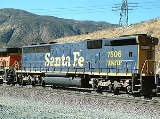
EMD SD45-2
Encyclopedia
An EMD SD45-2 is a 6-axle diesel locomotive
built by General Motors Electro-Motive Division beginning in 1972. Power was provided by an EMD 645E3 20-cylinder
engine which generated 3600 hp. Part of the EMD Dash 2
line, the SD45-2 was an upgraded SD45
.The main spotting difference between an SD45 and an SD45-2 was the long hood configuration and the rear radiator assembly. On the SD45 the long hood is flared whereas on the SD45-2 it is vertical and the rear cooling fans are more spread out over the top of the rear of the long hood. This unit shared the same common frame with the EMD SD40-2
and EMD SD38-2
. The largest owner of the SD45-2 was the Atchison, Topeka, & Santa Fe
with 90 units, the Clinchfield
had 18 units, Seaboard Coast
line had 15 units and Erie Lackawanna
rostered 13 units.
A few cabless
SD45-2Bs also existed; these were rebuilds of wrecked units by ATSF. In most cases, as in the example shown, the dynamic brake
s were moved to the opposite end of the hood from the radiator
s; they were originally near the center of the hood. These B Units are designed to be run with other locomotives. Santa Fe acquired more B units throughout their time with diesels than any other railroads in North America.
Locomotive
A locomotive is a railway vehicle that provides the motive power for a train. The word originates from the Latin loco – "from a place", ablative of locus, "place" + Medieval Latin motivus, "causing motion", and is a shortened form of the term locomotive engine, first used in the early 19th...
built by General Motors Electro-Motive Division beginning in 1972. Power was provided by an EMD 645E3 20-cylinder
Cylinder (engine)
A cylinder is the central working part of a reciprocating engine or pump, the space in which a piston travels. Multiple cylinders are commonly arranged side by side in a bank, or engine block, which is typically cast from aluminum or cast iron before receiving precision machine work...
engine which generated 3600 hp. Part of the EMD Dash 2
EMD Dash 2
On January 1, 1972, General Motors' Electro-Motive Division introduced its new Dash 2 line of diesel-electric locomotives. All designations of these new models were those of the former models with "-2" added...
line, the SD45-2 was an upgraded SD45
EMD SD45
The EMD SD45 is a six-axle diesel locomotive built by General Motors Electro-Motive Division between December, 1965, and December, 1971. Power was provided by an EMD 645E3 twenty-cylinder engine which generated 3,600 HP. This locomotive shared the same common frame with the EMD SD38, EMD SD39, EMD...
.The main spotting difference between an SD45 and an SD45-2 was the long hood configuration and the rear radiator assembly. On the SD45 the long hood is flared whereas on the SD45-2 it is vertical and the rear cooling fans are more spread out over the top of the rear of the long hood. This unit shared the same common frame with the EMD SD40-2
EMD SD40-2
The EMD SD40-2 is a C-C locomotive produced by EMD from 1972 to 1989.The SD40-2 was first introduced in January 1972 as the mid-range offering in EMD's six-axle "Dash-2" series, competing against the GE U30C and the MLW M630...
and EMD SD38-2
EMD SD38-2
An EMD SD38-2 is a six-axle diesel locomotive built by General Motors Electro-Motive Division from 1972 to 1979. EMD built 83 of these medium road-switchers, which were used in both yard and mainline roles. Part of the EMD Dash 2 line, the SD38-2 was an upgraded SD38 with modular electronic...
. The largest owner of the SD45-2 was the Atchison, Topeka, & Santa Fe
Atchison, Topeka and Santa Fe Railway
The Atchison, Topeka and Santa Fe Railway , often abbreviated as Santa Fe, was one of the larger railroads in the United States. The company was first chartered in February 1859...
with 90 units, the Clinchfield
Clinchfield Railroad
The Clinchfield Railroad was an operating and holding company for the Carolina, Clinchfield and Ohio Railway . The line ran from the coalfields of Virginia and Elkhorn City, Kentucky, to the textile mills of South Carolina...
had 18 units, Seaboard Coast
Seaboard Coast Line Railroad
The Seaboard Coast Line Railroad was a former Class I railroad company operating in the Southeastern United States beginning in 1967. Its passenger operations were taken over by Amtrak in 1971...
line had 15 units and Erie Lackawanna
Erie Lackawanna Railway
The Erie Lackawanna Railway , known as the Erie–Lackawanna Railroad until 1968, was formed from the 1960 merger of the Erie Railroad and the Delaware, Lackawanna and Western Railroad...
rostered 13 units.
A few cabless
B unit
A "B" unit, in railroad terminology, is a locomotive unit which does not have a driving cab, or crew compartment, and must therefore be controlled from another, coupled locomotive with a driving cab . The term booster unit is also used. The concept was largely confined to North America...
SD45-2Bs also existed; these were rebuilds of wrecked units by ATSF. In most cases, as in the example shown, the dynamic brake
Dynamic braking
Dynamic braking is the use of the electric traction motors of a railroad vehicle as generators when slowing the Locomotive. It is termed rheostatic if the generated electrical power is dissipated as heat in brake grid resistors, and regenerative if the power is returned to the supply line...
s were moved to the opposite end of the hood from the radiator
Radiator (engine cooling)
Radiators are used for cooling internal combustion engines, mainly in automobiles but also in piston-engined aircraft, railway locomotives, motorcycles, stationary generating plant or any similar use of such an engine....
s; they were originally near the center of the hood. These B Units are designed to be run with other locomotives. Santa Fe acquired more B units throughout their time with diesels than any other railroads in North America.

